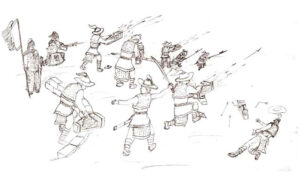Friday, so I get to post something a little more off the wall.
Recently I was enjoying the cartoon Korgoth of Barbaria. A great pity they only ever made the pilot. One interesting point of this Conan parody is that it is set in the future. It is a genre that might be termed Post-apocalyptic Heroic Fantasy. There have been a number of movies and books along these lines. One movie that immediately springs to mind is “Steel Dawn”, where we learn shoulder pads and 80’s hairstyles can survive just about anything. Novels along these lines include Sterling E. Lanier’s “Hiero Desteen” novels, Robert Adams’ Horseclans series and Fred Saberhagen’s “Empire of the East” and “Book of Swords” series. I have not read all of these, but plan to read some of these soon.
What strikes me about some of the stories in this genre that I have seen or read is that if anything they are too Medieval and fail to meet some of the potential of a post-apocalyptic society regressed to the Dark Ages. Would people in such a situation be using swords and bows? Very probably. The survivors of such an event would also have the benefit of knowledge, however. If you look through history it is obvious that some inventions could not be created until certain technological achievements had occurred. It is also obvious that some inventions could have appeared centuries earlier than they did, but the idea just never occurred to anyone. This is why some inventions were in use hundreds of years in one part of the world before they were introduced or discovered in others.
A society that exists centuries after a post-apocalyptic event may indeed rely heavily on animal transport and fight mainly with bows and swords. They may not be able to build Jumbo Jets or M16s, but they would know that such things were once possible. Likewise, they would know that lower technology devices such as steam engines, chemical matches and rockets are possible. Given a few decades they may be able to produce their own versions.

Let us consider some weapons. Gunpowder was being produced in China as early as the tenth century and there isn’t really any reason why it might not have been created earlier. Source the three components, mix them together and confine them in a tube and you have a rocket. It is very likely a future barbarian world would have rockets where the raw materials for gunpowder could be found. The Chinese made some interesting weapons by just adding simple rockets to arrows. Packed into a basket and given a common fuse, and a single soldier could fire scores of them into a formation within a couple of seconds. What is more, every soldier in a company or battalion could carry and fire such a device, then take up his bow or spear to fight in a more conventional fashion. Larger rockets, capable of starting fires or exploding were also relatively simple devices and could be fired from wagons or ships. While the ancient Chinese developed a number of rocket systems they were a weapon very much ignored in the West. This may be because in Europe the destruction of fortifications was more of a priority and cannon were better suited to such roles. China, in contrast, enjoyed a long period of peace so the development of gunpowder weapons languished somewhat during this time.
What of more conventional guns? Once you have the gunpowder, a muzzle-loading cannon is a relatively simple device that can be surprisingly potent. Casting a barrel takes some knowledge but could be established by research and experimentation. As late as the 19th century mortars and some other light guns were constructed from reinforced timber. In “Space Viking” by H. Beam Piper, a character opinions that gunpowder seems to be one of the last items of knowledge a decivilizing world loses.

Personal firearms pose a more interesting question. Many guns are mechanically very simple. Something like an M16 would be difficult to produce, relying on precision parts, polymers and aluminum castings. A Sten Gun, however, is just a few tubes and springs and such guns have been made in underground workshops and village forges as we know. The real challenge for our post-apocalyptic warriors will be in the production of ammunition. Producing something like self-contained modern pistol and rifle ammunition may prove too difficult. Ammunition may be more likely to resemble 19th century paper cartridges or shotgun ammunition. These are simpler to make and reload, but probably will not be suited to automatic or other complicated feed mechanisms. Where personal firearms may exist they may be more likely to be single-shot or double-barrelled weapons. Such guns may not have that many advantages over weapons such as the bow or crossbow. Making an arrow or quarrel requires more skilled labour than primitive firearm ammunition but can be reused. Compare a simple gun and a bow and you will find that the bow often outperforms the gun. Guns did not replace bows because of performance advantages but because they and their ammunition were easier to mass produce. If guns are to persist in the armoury of future barbarians it will most likely be if they offer a unique capability. Pistols and shotguns can supplement a sword in close combat, even if they are only single or double-shot. Rifles will have to compete with the bow so we are likely to see them designed more towards precision longer range shooting where their flatter trajectory offers some advantages.